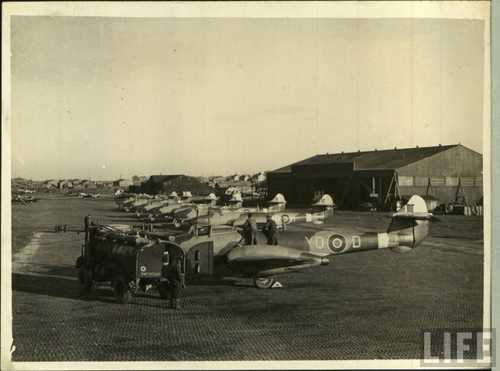
Gloster Meteor No. 616 Squadron
No. 616 Squadron RAF was the first to receive operational Meteors, 14 of them. The squadron was based at RAF Culmhead, Somerset and had been previously equipped with the Spitfire VII. After a conversion course at Farnborough for the six leading pilots, the first aircraft was delivered to Culmhead on 12 July 1944.The squadron now with seven Meteors moved on 21 July 1944 to RAF Manston on the east Kent coast and, within a week, 30 pilots were converted. The Meteor was initially used to counter the V-1 flying bomb threat. 616 Squadron Meteors saw action for the first time on 27 July 1944, when three aircraft were active over Kent. These were the Meteor's (and the Royal Air Force's) first operational jet combat missions. After some problems, especially with jamming guns, the first two V1 "kills" were made on 4 August. By war's end, Meteors accounted for 14 flying bombs. After the end of the V-1 threat, and the introduction of the ballistic V-2 rocket, the RAF was forbidden to fly Meteor F.1 on combat missions over German-held territory for fear of an aircraft being shot down and then salvaged by the Germans. In any case, the greatly improved F.3 was in prospect. No. 616 Squadron briefly moved to RAF Debden to allow USAAF bomber crews to gain experience in facing jet-engined foes before moving to Colerne, Wiltshire. Gloster Meteor F.3 No. 616 Squadron exchanged its F.1s for the first Meteor F.3s on 18 December 1944. This was a substantial improvement over the earlier mark, although the basic design still had not reached its potential. On 20 January 1945, four Meteors were moved to Melsbroek in Belgium. In March, the entire squadron was moved to Gilze-Rijen and then in April, to Nijmegen. The Meteors flew armed reconnaissance and ground attack operations without encountering any German jet fighters. By late April, the squadron was based at Faßberg, Germany and suffered its first losses when two pilots collided in poor visibility. The war ended with the Meteors having destroyed 46 German aircraft through ground attack and having faced more problems through misidentification as the Me 262 by Allied aircraft and flak than from the Luftwaffe.To counter this, continental-based Meteors were given an all-white finish as a recognition aid.(source Wikipedia)
This is a companion discussion topic for the original entry at https://www.ww2incolor.com/gallery/british-forces/39191/gloster-meteor-no.-616-squadron

